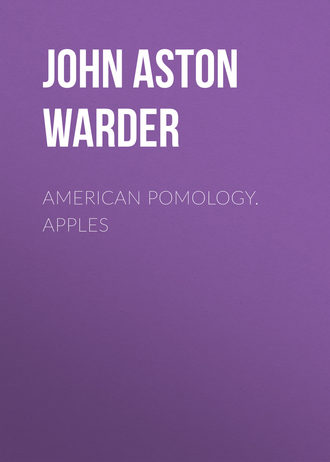 полная версия
полная версияПолная версия
American Pomology. Apples
Core closed; Seeds numerous, large, plump; Flesh greenish-yellow, breaking, firm, coarse; Flavor sub-acid, not rich; Quality only good, a market fruit, keeping well; Season March until May.
NyackNYACK PIPPINOrigin New York; specimen obtained from Mr. E.H. Warren, of Chelmsford, Massachusetts.
Fruit medium, flat, uneven; Surface smooth, greenish-yellow, mixed, striped, splashed bright red; Dots numerous, distinct, yellow, indented.
Basin shallow, folded; Eye small, closed; Axis short.
Cavity wide, deep, wavy, brown; Stem short, thick, knobby.
Core rather wide, closed, rather clasping; Seeds large; Flesh white, firm, juicy; Flavor acid, rich; Quality pretty good; Use table, market; Season December.
Ohio NonpareilMYER'S NONPAREIL—WESTERN BEAUTY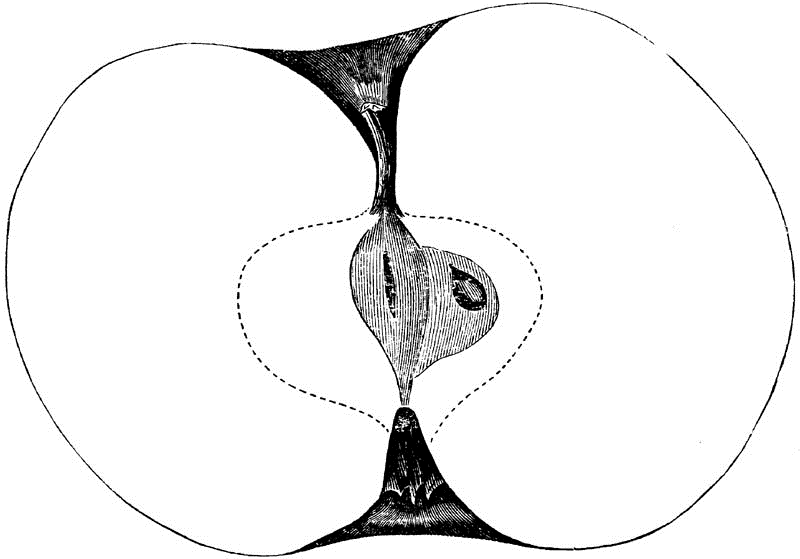
Fig. 102.—OHIO NONPAREIL.
This fine fruit originated with Mr. Myers, near Massillon, Ohio.
It was described in the Western Horticultural Review for February, 1853.
Tree vigorous, healthy, spreading, limbs straight, stout and compact, not liable to break with the weight of fruit. The original tree had borne annual crops of even sized fruit for twenty years.
Fruit large to very large, regular, oblate, very handsome; Surface smooth, yellow, covered with bright red; Dots scattered, gray.
Basin medium, wide, regular; Eye large, closed.
Cavity deep, acute, regular; Stem short, small.
Core regular, somewhat open; Seeds numerous, medium; Flesh yellowish, tender, fine-grained, juicy; sub-acid, rich; First quality, for table, market, cooking or drying; Season September to December. Compared with some of the best dessert apples of the season, such as Hawley, Fall Pippin, Fall Wine, Rambo, and others, this variety was declared to be "better than the best."
Osceola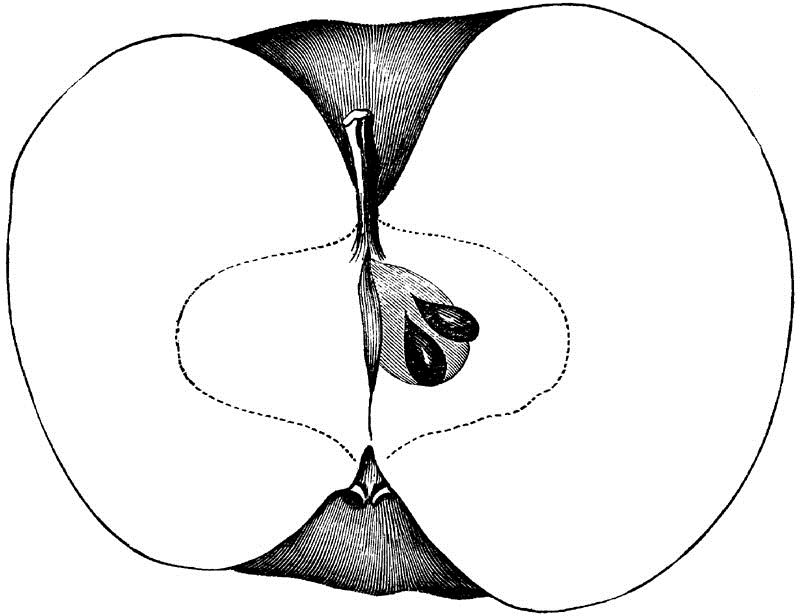
Fig. 103.—OSCEOLA.
Originated in Indiana, brought into notice by that earnest horticulturist, Henry Ward Beecher, who did much to stimulate the culture of fine fruits when a resident of that State.
Fruit medium, flattened, sometimes unequal, regular; Surface smooth, slightly colored red, and striped with the same; Dots scattered, irregular, more frequent and minute about the apex, few and larger at base of the fruit.
Basin wide, regular; Eye small, closed.
Cavity medium, acute; Stem short.
Core small, round, closed, clasping; Seeds numerous, plump, dark; Flesh yellowish, firm, rich, juicy; Flavor sub-acid, mild; Quality good; Use table and market; Season January to March.
This variety does not seem to have won its way into public favor to the extent that was expected for it some years ago.
PennockPENNOCK'S RED WINTER—ROMANITE—BIG ROMANITEThis fruit, of Pennsylvania origin, is not introduced into this collection on account of its excellence, but because it is so universally cultivated in nearly all parts of the country.
Tree vigorous, large, spreading, very productive, bearing some fruit every year.
Fruit large to very large, form variable, but characteristically it is conic-oblate, often unequal, and lop-sided; Surface greenish-yellow, covered with mixed and striped red; Dots large, irregular and round, gray.
Basin wide, rather deep, uneven or wavy; Eye large, open.
Cavity wide, deep, regular; Stem short.
Core irregular, closed, meeting the eye; Seeds numerous, angular, plump; Flesh yellow, breaking, coarse-grained; Flavor sub-acid, poor; third quality; for cooking and market only; Season December; very much disposed to bitter rot.
Pennsylvania VandervereVANDERVERE (Coxe and Downing)—LITTLE VANDERVERE—GRAY VANDERVERE—STAALCUBS, ETCThis old kitchen favorite, of Pennsylvania, has migrated westward until it has reached every State and county on its appropriate parallels of latitude, 39° to 42°.
Mr. Downing gives Delaware as its origin, on the authority of Coxe. In accordance with common acceptance in the regions where it is best known, I have adopted the above name, which was given to distinguish it from several other Vanderveres, and especially from the Newtown Spitzenberg, to which the name Vandervere had been applied in New York and westward on that parallel. Coxe describes the fruit in question under the name Vandervere.
Tree vigorous, healthy, large, spreading, very twiggy and drooping, with abundant fruit on the ends of the spray; Foliage bright yellowish-green, shining, pointed, the whole aspect of the tree peculiar and characteristic in summer or winter.
Fruit medium or less, oblate, or globular-oblate, regular; Surface smooth, but having raised hemispherical warts of a yellow russet color, yellow, mottled, and striped light red, often a gray appearance over the whole exterior; Dots large, yellow, indented.
Basin wide, regular, not deep; Eye small, closed.
Cavity wide, regular; Stem long, slender.
Core regular, closed, meeting and clasping the eye; seeds numerous, pointed, plump; Flesh yellow, breaking, granular, juicy; Flavor highly aromatic, acid; Quality for table third, for kitchen first, for cider Coxe says very good, yielding a heavy must; Season December and January.
The fruit is subject to bitter rot, and does not keep well, but may be used for cooking as soon as any other apple, making good sauce in July, when not half grown.
PottingerBIG RED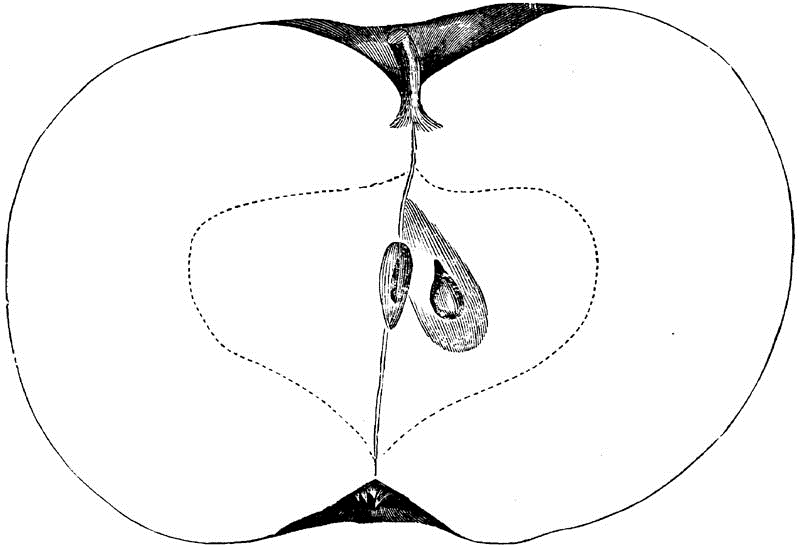
Fig. 104.—POTTINGER.
This large market fruit is found chiefly in regions settled by immigrants from the South, and it may prove to be the same as some other southern apple. Specimens first received from my friend J.B. Orange, in Southern Illinois, afterwards from several other points.
Tree vigorous, large, branches upright, shoots purple, warty, buds long, pointed.
Fruit large, regular, oblate; Surface not smooth, dull red, shaded and striped, covering the yellow ground; Dots small, prominent, with some roughness.
Basin regular, wide, not deep; Eye small, closed.
Cavity wide, regular, green and brown; Stem medium to short.
Core closed, or nearly so, meeting and partially clasping the eye; Axis short; Seeds numerous, plump, angular; Flesh yellow, breaking, granular, juicy; Flavor sub-acid, aromatic; Quality only good; Useful for kitchen and drying; Season December and January; keeps well.
Press Ewing
Fig. 105.—PRESS EWING.
This Kentucky apple was sent me by J.S. Downer, from whom trees were also procured which have already borne fruit.
Tree vigorous, healthy, and early productive.
Fruit resembles Smokehouse, medium, roundish-oblate, regular; Surface smooth, bright red, mixed, striped, and splashed, on greenish yellow; Dots numerous, brown and yellow.
Basin wide, wavy, regular, rather deep; Eye medium, open; calyx reflexed.
Cavity wide, wavy, brown; Stem long, slender.
Core medium, closed, meeting the eye; Axis short; Seeds numerous, angular, pointed; Flesh yellow, fine-grained, tender, melting, juicy; Flavor rich sub-acid; Quality nearly first rate; Use for table in December and January.
Powers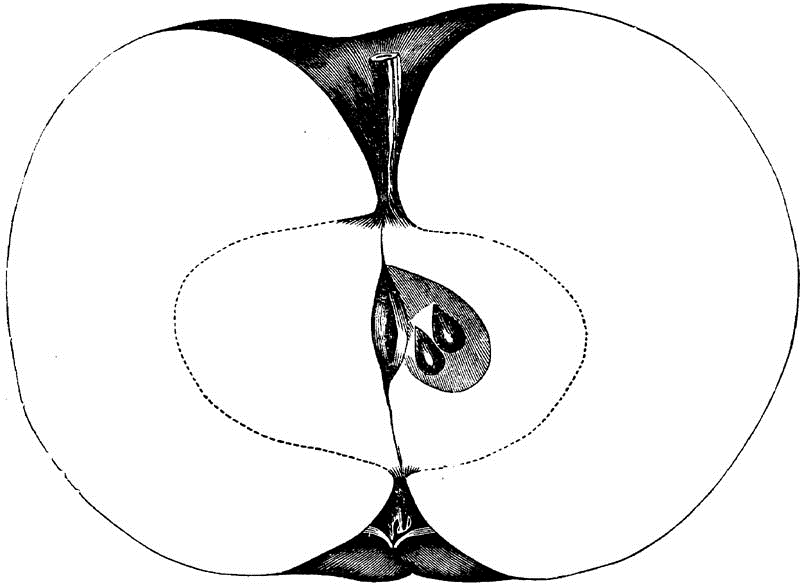
Fig. 106.—POWERS.
This beautiful table apple was first brought to public notice by Geo. Powers, of Perrysburgh, Ohio. He exhibited specimens at the Toledo meeting of the Ohio Pomological Society in January, 1864, but the fruit was over ripe; at the State Fair at Dayton, Ohio, October 16th, it was shown in perfection of beauty and excellence, and was then examined by the Society, who commended it highly, and being satisfied that it was an original seedling, its local name, Miller's Apple, was then changed to Powers, in honor of the pomologist who had brought it into notice.
The tree appears to have been an accidental seedling, which sprang up in the town of Perrysburgh, where it grew almost without care until it fruited a few years ago, and attracted the attention of Mr. Powers.
The fruit is large and fair, round, somewhat flattened, and sometimes rather conic, generally regular, but large specimens are slightly angular; the surface is very smooth, a greenish waxen yellow, more or less shaded with mixed light red, upon which are laid numerous stripes and broken splashes of rich, dark carmine; Dots minute, scattered, gray.
Basin abrupt, regular, or folded; Eye small, closed.
Cavity deep, regular, sometimes brown; Stem medium or short.
Core medium or wide, regular, closed, meeting the eye; Seeds numerous, plump, sometimes imperfect; Flesh white, very tender, juicy; Flavor mild sub-acid, quite aromatic, very agreeable; Use especially for the table, as a highly ornamental dessert fruit, for which its extreme delicacy adapts it, while the same quality unfits it for general market purposes; Quality very good; in its season of ripening, in its beautifully white and tender flesh, and in its perfumed flavor, this fruit resembles the Fameuse, from which it may have been produced.
Prolific Beauty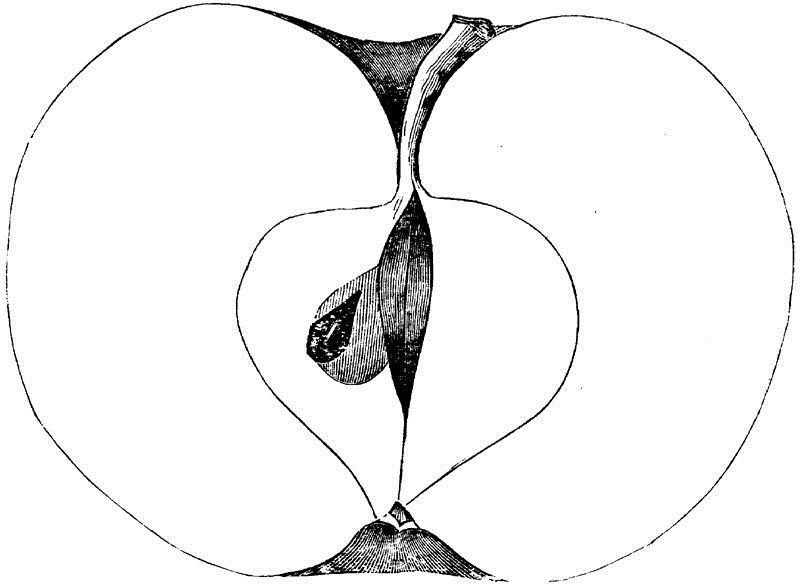
Fig. 107.—PROLIFIC BEAUTY.
This showy fruit is one of the original Putnam list of Washington County, Ohio; it is somewhat singular that so few choice sorts are traceable to the seeds of these first good orchards of the West. Rome Beauty is almost the only one of great notoriety that is referable to this source.
Fruit large, sometimes quite large, oblate, somewhat conic, regular; Surface smooth, yellowish-green, partially covered with stripes of red; Dots minute, gray.
Basin medium, wide, regular; Eye small, closed.
Cavity wide, wavy, green; Stem medium.
Core large, regular, open, clasping; Seeds numerous, plump; Flesh whitish-yellow, tender, juicy; Flavor acid; quality scarcely good; Use kitchen, market; Season September to December.
RamboROMANITE OF NEW JERSEY—BREAD-AND-CHEESE, ETC
Fig. 108.—RAMBO.
This standard Eastern Pennsylvania variety is universally popular, and through the Western States it marks the progress of emigration from the Keystone State, though its admirers are not confined to that class of our population. It is a fall and early winter fruit, and some pomologists on the southern borders of its culture object to it that it will not keep long, and that it soon becomes dry and mealy when put away. When grown further north it is smaller, but more solid, and remains juicy until spring. It should be gathered early, even before it is well colored, and kept cool to make it retain its flavor and juiciness.
Tree upright, very thrifty, very productive; shoots dark, foliage large, light green, and thus the variety may easily be distinguished in the orchard. Not very hardy; whole nurseries and orchards were destroyed, in 1856, throughout the Northwest.
Fruit medium to small, when crowded upon the limbs as they generally are upon old trees, regular, oblate, or roundish-oblate, but sometimes unequal when overgrown; large specimens are flattened at the ends so as to appear truncate; Surface striped and splashed scarlet on greenish-yellow, in some the stripes coalesce so as to make the skin red, the ground color being covered; Dots numerous, small, prominent, rich bloom.
Basin wide, abrupt, regular or plaited, sometimes quite shallow; Eye small, closed.
Cavity wide, regular, always green; Stem medium.
Core regular, closed, meeting and clasping the eye; seeds numerous, large, angular; Flesh greenish-white, tender, breaking, granular, juicy; Flavor sub-acid, aromatic, vinous; Quality almost first rate for table, excellent for the kitchen; Season October to December, and if gathered early in the North, until spring.
Red Astrachan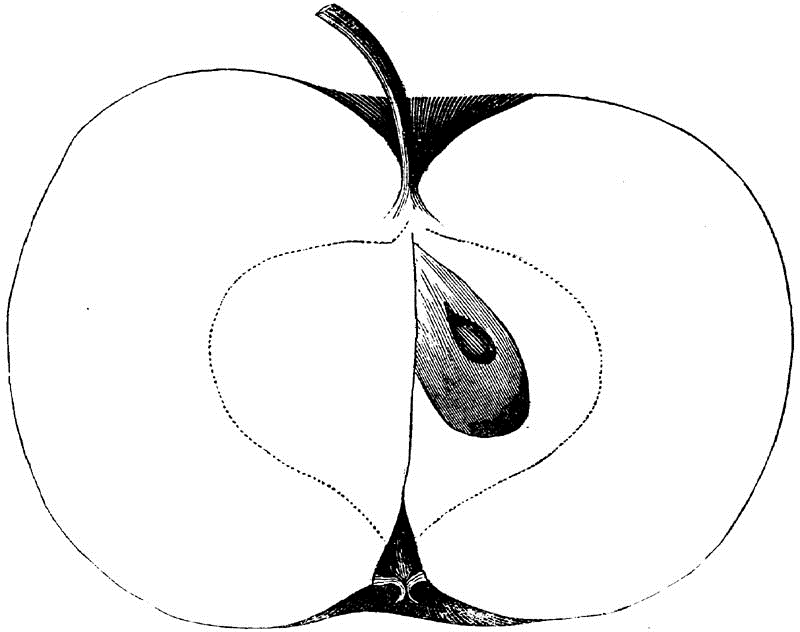
Fig. 109.—RED ASTRACHAN.
This Russian fruit has been perfectly adopted by our countrymen, and has proved itself a great favorite, particularly in the North, by its hardiness and productiveness, beauty and good qualities.
Tree vigorous, upright, productive, hardy; Shoots reddish brown, foliage large, rich green.
Fruit medium to large, regular, oblate; Surface smooth, mottled, marbled and striped crimson on greenish-yellow; Dots minute, heavy bloom.
Basin medium, regular; Eye small, closed.
Cavity shallow, regular; Stem long, yellow.
Core regular, closed; Seeds angular, small, dark; Flesh yellow, breaking, juicy; Flavor quite acid, not rich; Quality first rate for market and cooking, poor for table; Season July.
Richard's GraftRED SPITZENBERG—STRAWBERRY—WINE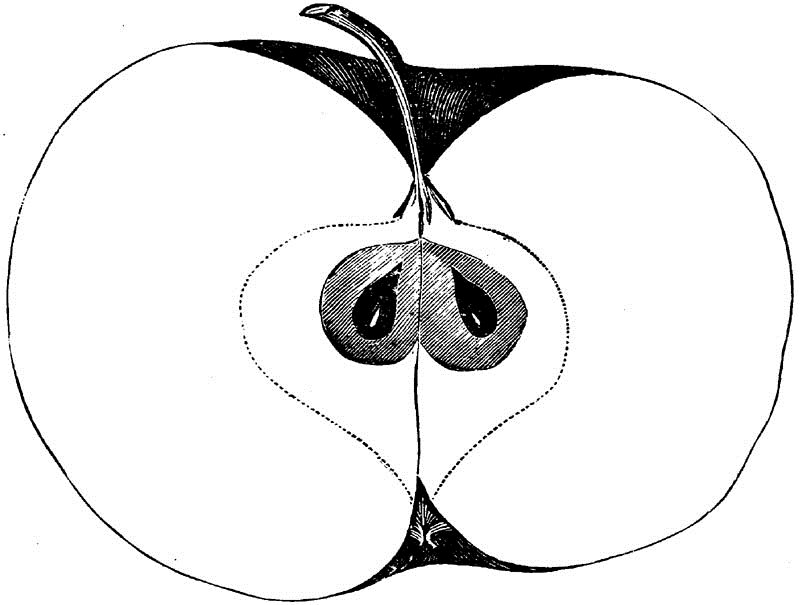
Fig. 110.—RICHARD'S GRAFT.
Supposed to have originated in Ulster County, New York. Tree vigorous, upright, very productive.
Fruit medium to large, regular, oblate; Surface smooth, greenish-yellow, mixed and splashed red; Dots numerous, white.
Basin medium, abrupt, folded; Eye small, closed.
Cavity wide, regular; Stem long, red.
Core small, closed, clasping the eye; Seeds numerous, plump; Flesh yellowish-white, fine-grained, tender, juicy;
Flavor rich, sub acid; Quality best; Use for the dessert; Season September and October.
Downing says: "One of the best dessert apples of its season."
Rome BeautyGILLETT'S SEEDLING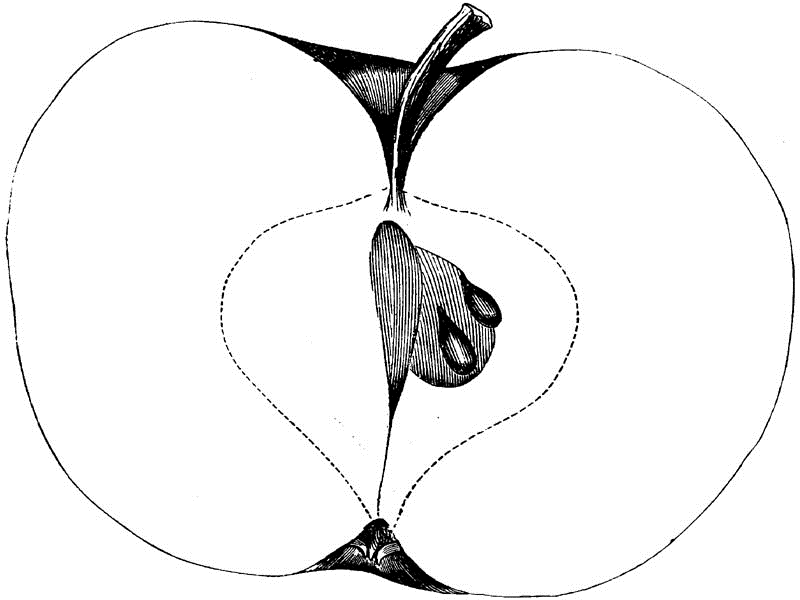
Fig. 111.—ROME BEAUTY.
This handsome market fruit was originated in Southern Ohio, by that sterling pioneer pomologist, H.N. Gillett, to whose contributions I acknowledge myself under many obligations.
Tree thrifty, hardy, round headed, very productive; shoots slender, red; Foliage healthy; Blossoms open late, and thus it often escapes a late frost; early productive.
Fruit large to very large, regular, handsome, fair, said to be scabby on old trees, regular oblate, roundish-oblate, and sometimes rather conical; Surface smooth, pale yellow, striped and mixed bright red; Dots minute, indented.
Basin wide, deep, regular; Eye quite small, closed.
Cavity wide, wavy, green; Stem long, slender.
Core wide, regular, closed, meeting the eye; Seeds numerous, long, pointed; Flesh yellow, breaking, coarse-grained; Flavor sub-acid, not rich; Quality scarcely good; valuable for market, on account of its productiveness, size and beauty, as well as for its certain bearing; Season December to February.
Shiawassee Beauty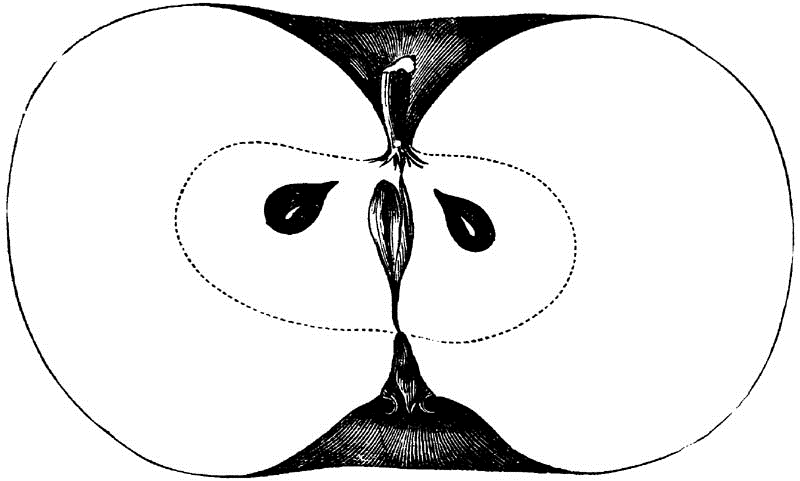
Fig. 112.—SHIAWASSEE BEAUTY.
This Michigan apple may well be called Beauty. It was introduced at the meeting of the American Pomological Society in 1862, by T.T. Lyon, of Plymouth, Mich., who stated that it was a seedling of the Fameuse, the faults of which it does not inherit, though possessing all the good qualities of its parent, with a healthy and productive tree. (See Michigan Farmer, Dec. 11, 1859.)
Fruit medium, very handsome, very regular, quite flat; Surface very smooth, pale yellow, mixed and distinctly striped carmine; Dots scattered, minute.
Basin wide, folded; Eye medium, closed; Calyx reflexed.
Cavity wide, wavy; Stem short.
Core wide, regular, somewhat open, meeting the eye; seeds plump, short, dark; Flesh very white, fine-grained, tender, breaking; Flavor sub-acid, aromatic; Quality good to very good; Use dessert and market; Season October to January.
Summer Limbertwig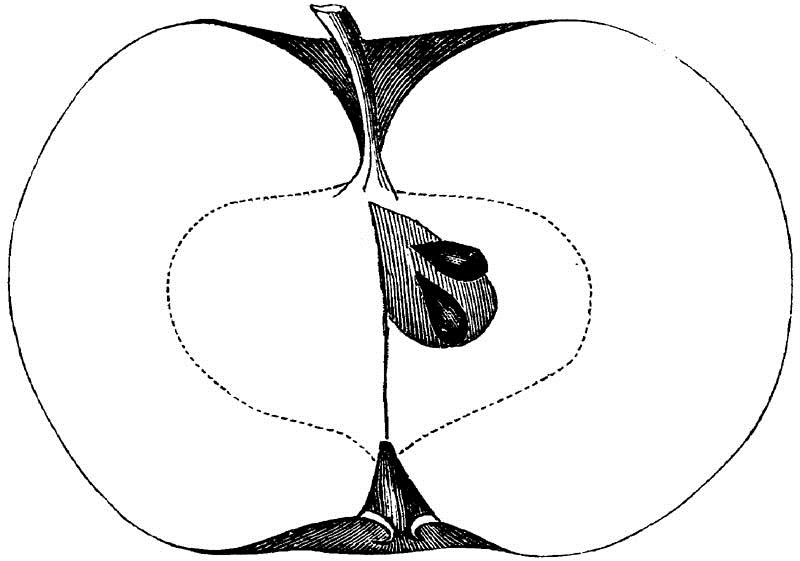
Fig. 113.—SUMMER LIMBERTWIG.
Southern; obtained from S. Westbrooke, Greensboro', North Carolina.
Fruit medium, flat, regular; Surface pale yellow, mixed pink, striped dark red; Dots minute, gray, indented.
Basin shallow, wide, regular; Eye wide, open.
Cavity acute, regular, brown; Stem long, inclined.
Core wide, regular, closed, clasping; Axis short; Seeds numerous, plump, dark; Flesh white, tender, fine-grained, juicy; Flavor sub-acid, aromatic, agreeable; Quality very good, if not best; Use table; Season August, September.
TownsendHaving been disappointed in my trees obtained for this variety, which proved to be Rawle's Janet, I prefer to quote from Mr. Downing. What I have fruited and described as the Hocking may prove to be the same.
"Origin Pennsylvania. Tree healthy, vigorous, very productive.
"Fruit medium, oblate, slightly conic. Skin pale yellow, striped and splashed with red, and covered with a thin bloom. Stalk rather long, slender, inserted into a medium cavity. Calyx closed, set in a basin of moderate depth. Flesh white, tender, very mild, agreeable, sub-acid flavor. Ripe middle of August to middle of September. Hocking of the West may prove to be the same."
Trader's FancyThis peculiar looking apple originated in Washington County, Pennsylvania. Tree vigorous, healthy, spreading, round-headed, very productive, bears regularly. As a long keeper, with dark skin, that does not show bruises, it became a favorite with shippers on the Ohio river, hence its name, the flat-boats that stop from port to port to dispose of their cargoes being called trading boats, and their masters traders.
Fruit medium, regular, oblate; Surface very smooth, greenish yellow, almost completely obscured with deep purple red, mixed and striped, and covered with a white bloom.
Basin wide, sometimes folded or plaited; Eye small, closed.
Cavity wide, regular; Stem medium, slender.
Core medium, closed; Seeds plump; Flesh whitish, tender, fine-grained; Flavor mild sub-acid; Quality only good; Use market and kitchen; Season January to May.
Twenty-Ounce PippinOrigin unknown, and the variety never should have been distributed; it is here named to put people on their guard against it when they desire to purchase the Cayuga Red Streak, also called the Twenty-ounce apple.
Fruit large, flat, regular; Surface greenish, more or less mottled and striped dull red.
Basin, wide, regular, or wavy; Eye small, open.
Cavity wide, regular, green; Stem short, thick.
Core large, closed; Seeds numerous, angular; Flesh yellow-white, breaking; Flavor acid, with a peculiar aroma, not agreeable; Quality poor; Use kitchen only; Season November to January. There are many better apples of its season.
Vance's HarvestA pretty little early apple grown in some parts of the West. Origin unknown.
Fruit small, flat, regular; Surface smooth, rich yellow, shaded and splashed bright red; Dots small, scattered, yellow.
Basin small, regular; Eye small, closed.
Cavity wide, regular, brown; Stem long.
Core wide, regular, meeting the eye; Seeds numerous, short, plump, dark; Flesh yellow, firm, breaking, not very juicy; Flavor acid to sub-acid; Quality pretty good; Use kitchen and market; Season August.
Vandervere PippinLARGE VANDERVERE—WATSON'S VANDERVERE—VANDERVERE (Elliott)—YELLOW VANDERVERE—and several others in the booksThere appears to have been much confusion in the minds of authors who have written of this fruit, which, in some parts of the country is very well known and much cultivated. I have taken the name by which it is almost universally recognized by cultivators, though it is adopted only as a synonym by Mr. Elliott, who seems to have confounded this apple with the Pennsylvania Vandervere or Staalcubs described by Coxe.
Origin believed to have been Pennsylvania, but this is not well established.
Tree very vigorous, large, spreading, productive, bearing annually; Twigs and leaves much like the Pennsylvania Vandervere.
Fruit large to very large, regular, oblate; surface smooth, yellow, more or less covered with marbled red, and scarlet stripes; Dots large, yellow, indented, sometimes irregularly net-veined, making it less smooth.
Basin wide, regular; Eye small, closed.
Cavity wide, regular; Stem long, medium size.
Core regular, closed, meeting and clasping the eye; Seeds numerous, dark; Flesh yellow, firm, breaking, granular, juicy, heavy; Flavor rich, acid; Quality poor for table, excellent for cooking; Season December. Does not keep well, rather subject to bitter rot, but a great favorite with house-keepers, and a useful shade tree near the kitchen door.
Vaughan's Winter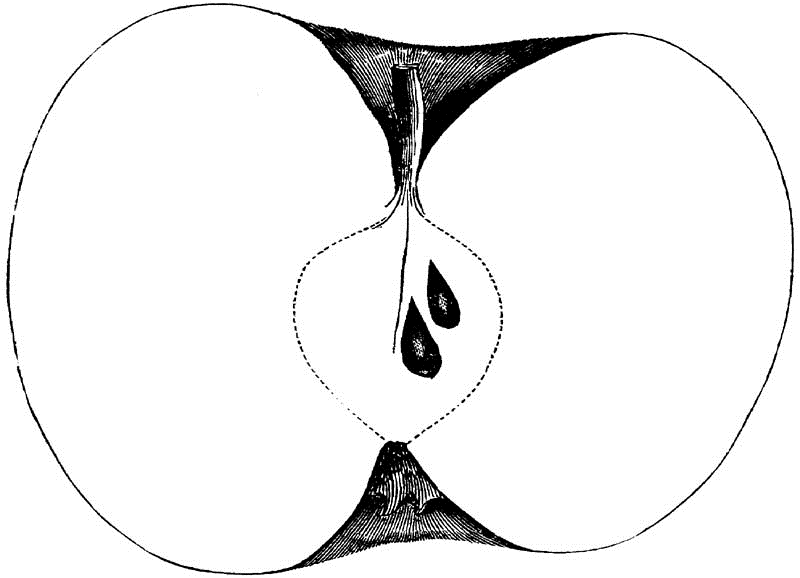
Fig. 114.—VAUGHAN'S WINTER.
This Kentucky variety was sent to me by my friend J.S. Downer, of Fairview, Kentucky, with several other new southern apples of merit. Tree vigorous, hardy and productive, bearing fruit early.
Fruit medium, regular, round-oblate; Surface smooth, greenish-yellow, mixed and splashed with bright red and splashes of carmine; Dots small, gray and yellow.
Basin regular, abrupt, medium, and leather-cracked; Eye large, open; Segments reflexed.
Cavity medium, yellow and brown; Stem short.
Core small, regular, closed, meeting the eye; Seeds few, large, brown; Flesh yellow, breaking, fine-grained, juicy; Flavor sub-acid, good; December.
Western BeautyMUSGROVE'S COOPER—BIG RAMBO—OHIO BEAUTY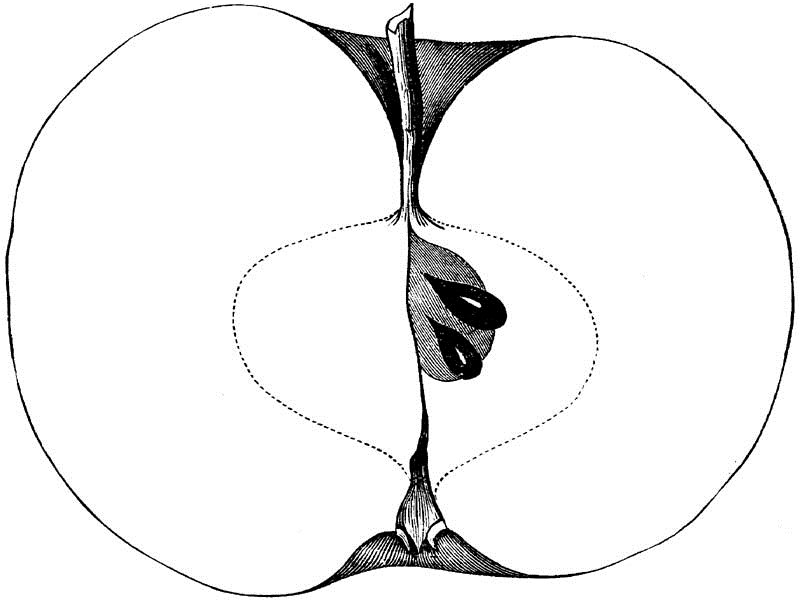
Fig. 115.—WESTERN BEAUTY.
A valuable fall and early winter fruit, the origin of which is not known; it is considerably grown in Central Ohio, and has attracted attention under its synonyms as given. It was at one time thought to be the Cooper.
Mr. W.F. English, of Auglaize County, Ohio, carried grafts into that region from Pickaway County, and in a most disinterested manner exerted himself to distribute the variety. In a communication to the Western Horticultural Review, for February, 1853, he says: "The tree is vigorous, leaves upon young shoots are often three to three and a half inches broad, and four or five, and even six inches long; shoots stout, being often as large as your little finger at the end of the summer's growth. The form of the tree is peculiar, and its appearance beautiful; once seen, it may be recognized anywhere by its habit."
Having fruited this variety in my own orchard, I can confirm the above, and add:
Tree vigorous, large, spreading, open head, productive, an early bearer.
Fruit large, sometimes very large, beautiful, regular, oblate, not disposed to rot, except when attacked by the birds, which are very fond of it; Surface smooth, pale yellow, partially covered with mixed red, striped and often distinctly splashed with bright red; Dots numerous, gray, prominent; Skin quite thin.
Basin wide, regular, sometimes cracked open; Eye large, closed.
Cavity wide, regular, green, and partly brown; Stem either short or long.
Core large, nearly closed, clasping the eye; Seeds numerous, medium, pointed; Flesh light yellow, almost white, brittle, tender, juicy, almost melting, never water-cored; Flavor sub-acid, vinous, delicious, satisfying; Quality best; either for table or cooking, for the latter purpose they may be taken when half grown in the beginning of July. In August they may be house-ripened and found good, but the proper season is September to Christmas; if properly cared for they may be preserved plump until March, but lose some of their refreshing flavor.
Wilson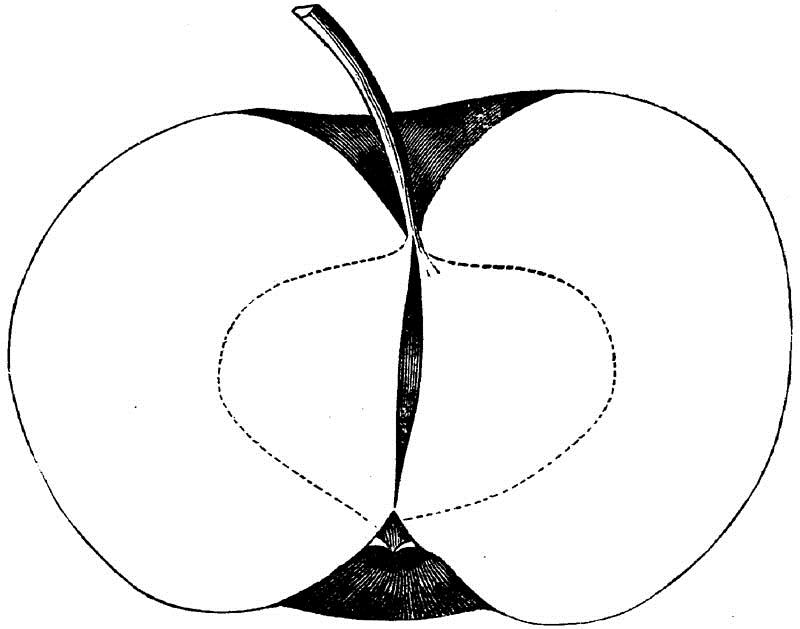
Fig. 116.—WILSON.
This very nice little apple was sent to me with this name from Western Virginia, by Julius Brace, who found it abundant on Paint Creek. I have not yet been able to identify it, but it may prove to be the same as some of our new southern varieties. An outline and description are here given with its local name, in the hope that if it should prove to be the same as the Black Annette, of the Clinch river region of Virginia, or some other variety, the identity may be the more readily traced.



